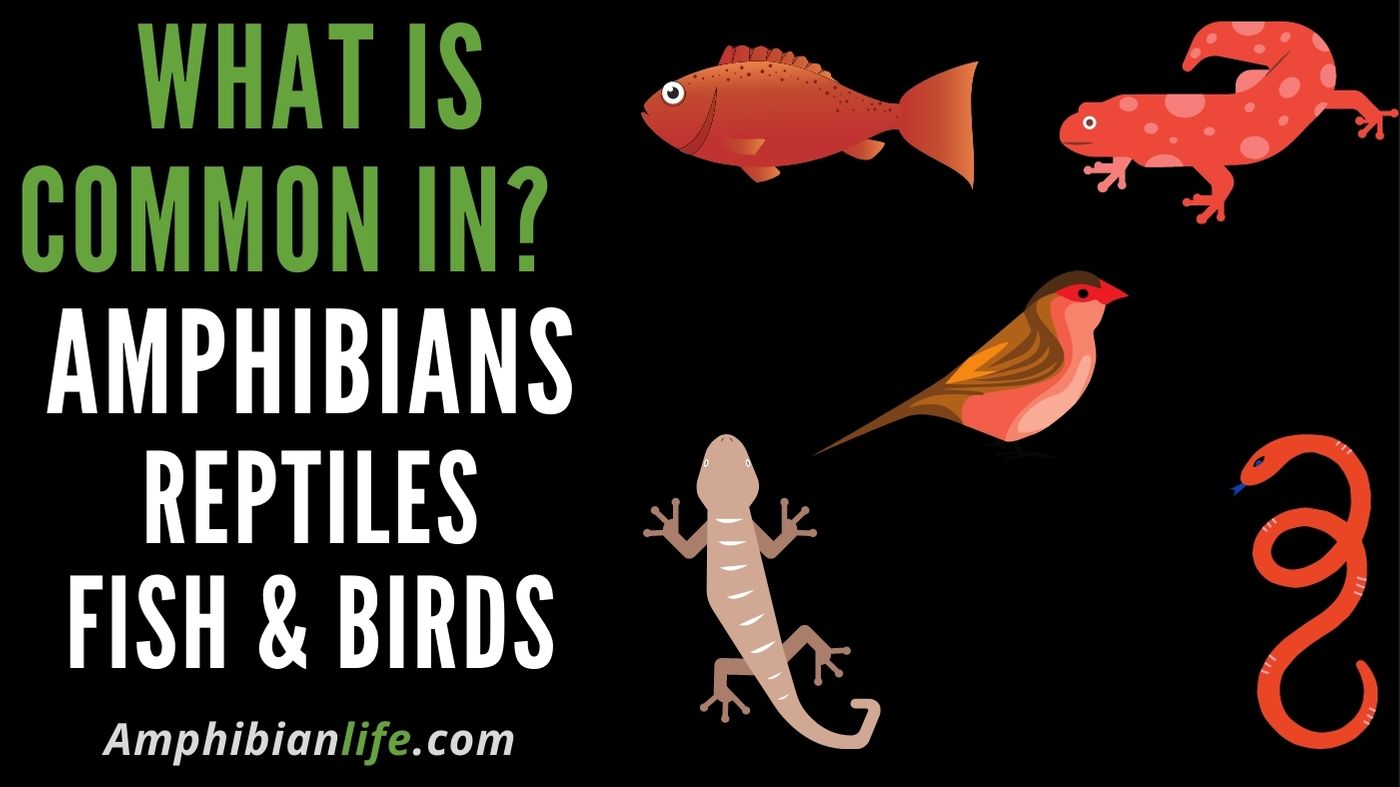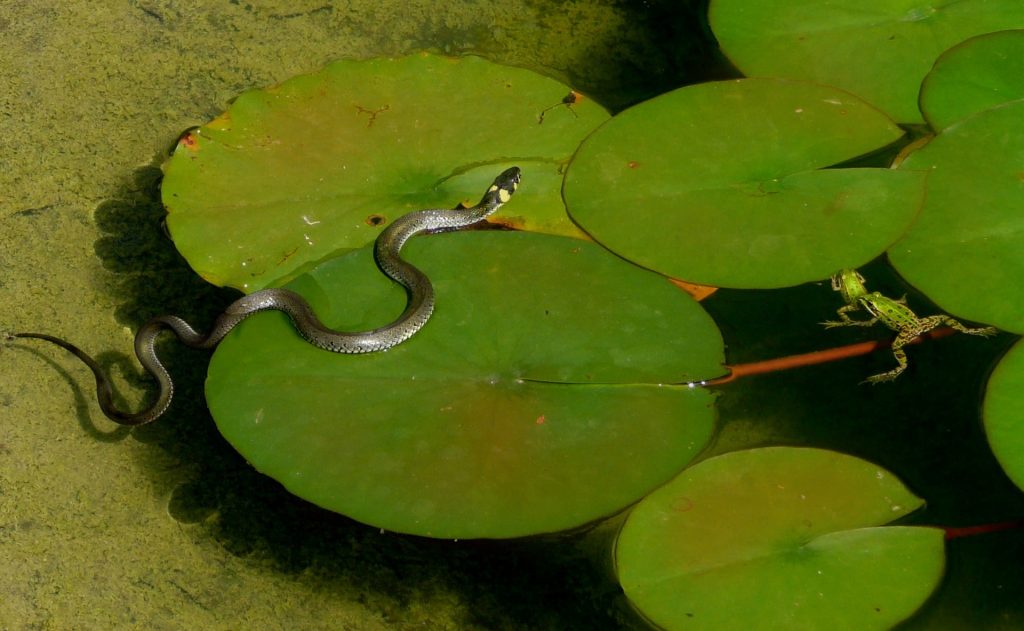
We’ve all seen birds, reptiles, and amphibians – and hopefully, from reading this website, you know what an amphibian is – but have you ever found yourself questioning how these animals are alike?
If so, you’re not alone! This afternoon I sat in my backyard and thought about the different animals and how they are alike. I tried to list a few things but this was harder than I thought.
I did not come further than that they’re all made up of cells, they all reproduce and they all evolve. But I was sure there were other things as well.
So I jumped up and ran to my computer destined to find the answers.
If you would like to know what birds, reptiles, amphibians, and fish have in common, then read on!
What do these animals have in common?
These animals have much in common. These animals all need and use energy, they are all made up of cells, they also all have bones which means that they’re vertebrates, and they all use muscles to move around from one place to another. But there are other similarities too.
Below you’ll find a list of what these animals have in common.
1) A separate organ system
An organ system is nothing more than a group of organs that work together to make what is called a “biological system” perform just one or multiple functions.
Each organ in the group has a separate function and helps to let the whole biological system work. This is the same as for humans.
2) Jaws
All the animals have a jaw. The jaw functions as the framework of the mouth. With vertebrate animals, this usually also means that they have teeth and a moveable lower jaw.
Now the jaw seems like a normal thing to have, but not every animal has it. Agnatha, for example, is a superclass of jawless fish.
3) Reproductive organs
Now, this is something you probably already know. How would the species otherwise reproduce? But Let me explain how they do this exactly.
Birds: How do birds mate?
The first thing that you need to know is the fact that most male birds don’t have penises.
Instead of that, both male and female birds have something that is called the cloaca.
The cloaca is a kind of “internal chamber” that ends in an opening. And it is through this opening that the bird’s sex organs (testes or ovaries depending on if it’s a boy or girl) release sperm or eggs.
When it is mating season, this cloaca swells by both females and males to the point that it protrudes slightly outside of their bodies.
When the two birds want to have sex, they rub their cloaca’s together and so the sperm is deposited in the cloaca of the female where it will fertilize an egg.
Amphibians: How do Amphibians mate?
With amphibians, it is a little simpler than with birds (at least that is what I think). Most female amphibians will lay eggs and then the male will fertilize those eggs.
In frogs, for example, it goes like this:
In the mating season, the male frog starts looking for a female to mate with nearby a pond.
When he found a female, he climbs on top of her and when the female discharges the eggs in the water, the male fertilizes them with his sperm.
Here is an article I wrote about why amphibians lay eggs in the water.
Reptiles: How do Reptiles mate?
They are similar to birds (this is because birds are considered reptiles). They all have an opening which is called the cloaca. This time let me give you an example of how snakes do it.
In snakes, the males have 2 penises (they call this hemipenes). And those are stored inverted inside of the tail.
Now when the male snake is horny, one of the penises flips itself inside out and then goes through his cloaca (just like with the birds where the sex organs come out of their bodies).
When he finds a female, he will ride on top of her and tries to align his tail with the tail of her.
When the female snake also wants to mate, she will lift her tail and opens her cloaca so that the male can come inside her.
Then the sperm goes into the female and fertilizes the eggs.
Fish: How do Fish mate?
In fish, it can vary a bit because different species of fish, have a different kinds of reproductive strategies:
1) Oviparity
This means that the embryo develops inside the egg, but outside of the body.
This method required that the female lays eggs that then need to be fertilized by the male.
2) Ovoviviparity
This means that the fertilization and the development of the embryo happens inside of the mother. But how does it work?
The female gets impregnated by the male’s modified anal fin. Then sperms are released into the female’s body and so the fertilization happens.
3) Viviparity
This means that the gets fertilization of the embryo takes place inside the mother’s body and eventually leads to a living birth.
I was shocked about the fish part a bit. I didn’t think there were so many ways in which fish would reproduce! Some fish like sharks both lay eggs and give birth to babies.
Now that we have looked at what all these animals have in common, let’s look at some things that the animals do not have in common.

What Are Differences Between birds, Reptiles, Amphibians, And Fish?
They are not all warm-or cold-blooded
This may or may not come as a surprise but not all animals are warm or cold-blooded.
Birds, for example, are warm-blooded which means that they can make their body heat (even when it is cold outside) just like us.
Now in frogs, this is different. Frogs are cold-blooded. This means that frogs take on the temperature of their surroundings.
That is why sometimes you see them lying in the sun and sometimes in the shadow or the water. They need to regulate their body temperature that way.
Reptiles are also cold-blooded, so they are also dependent on the temperature outside. The same goes for fish!
That is why you don’t see any feathers on reptiles, amphibians, and fish.
They do not need anything to keep their body warm. The only thing they need is a good environment.
The difference in the hearts and urea
There is also a difference between fish and amphibians. Amphibians have a heart that contains three chambers, while the fish have only two.
Another difference between the two is the fact that amphibians have a bladder that produces urea and fish extract their nitrogenous waste as ammonia from their gills.
When we look at amphibians and reptiles, we also see that there are some differences.
Amphibians live “dual lives” (which means that they spend half their life in water and the remaining half on land), and reptiles are a group of animals that live on land.
Also, reptiles have scales on their body and function to retain moisture. So, the differences between the two are primarily in their life cycle and appearance.
Related questions
What are the 5 classifications of animals?
Now that you know the differences and similarities of the animals, you might wonder what the five classifications are.
Here they are mammals, birds, fish, reptiles, and amphibians.
Is there a difference between amphibians and a reptile I don’t know about?
Reptiles usually have dry, scaly skin and a kind of leathery eggs, where amphibians lay soft eggs with a jelly-like substance around them in the water.
There is also the difference that some amphibians (like the frog) lay up to 20.000 eggs and with reptiles, this varies from 150 to just one or two.
Want to know more about why frogs lay so many eggs?
